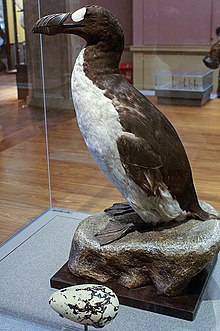Pinguinus alfrednewtoni
The fossils of Pinguinus alfrednewtoni were discovered in the Lee Creek phosphate mines of the Yorktown Formation in North Carolina.
A large and heavy ulna served as the holotype, while the remaining fossils (including a femur, two humeri and some other leg bones) were designated as the paratypes.
Notably, the ulna isn't as compressed as in the more recent form and shows a greater curvature to its shaft, while both the external and internal cotyla are wider in proximal view.
[3] Overall, the proportions greatly resemble Pinguinus impennis, with the differences in the wing bones indicating that P. alfrednewtoni was a slightly less specialised animal compared to its Pleistocene relative.
Although some researchers draw parallels to penguins, Smith urges against direct comparison between these phylogenetically distant groups.
Smith suggests that the large size obtained by some lineages of auks including Pinguinus alfrednewtoni are the result of these animals no longer being constrained by the need to remain light enough to stay volant, allowing them to grow much larger than their flying relatives.
This may have effectively split the Atlantic in two between an eastern Pinguinus species (ancestral to P. impennis) and the western P. alfrednewtoni, with the former expanding westward following the latter's extinction.
[3][6] Like the great auk, P. alfrednewtoni was a flightless wing-propelled diver, meaning that they used their wings to propel themselves forward underwater in a fashion similar to penguins.
While this locomotion is used by both flying and flightless auks, Smith suggests that the body weight limit for volant alcids lies at 2–2.5 kg (4.4–5.5 lb), which is exceeded by P. alfrednewtoni by nearly twice.
[4] The anatomy of the forelimbs in the Pliocene form, in particular the lesser flattening of the bones, indicates that it may have been slightly less specialised for this lifestyle than the later great auk.
Another indicator of this being the case is the angle of the distal tendinal grove, which would allow P. alfrednewtoni a greater ability to flex its wing tips.
This could suggest that the flightless P. albertnewtoni preferred coastal waters and did not regularly venture as far out to sea as other alcids native to the region.


